Effect of Heat Treatment on Mechanical Properties and Fracture Behavior of Al-7.0Si-0.3Mg Alloy at Low Temperature
Abstract
:1. Introduction
2. Experimental Section
3. Results
3.1. Effect of Solution Treatment on Low-Temperature Mechanical Property
3.2. Effects of Aging Treatment on Low-Temperature Mechanical Property
4. Discussion
4.1. Effect of Heat Treatment on Fracture Behavior
4.2. Effect of Diffusion Enhancement on Dislocation Motion
5. Conclusions
- (1)
- The resistance of the dislocation movement in α-Al increased in the low-temperature conditions, which was beneficial to the increase in the number of Si phase fractures, which enhanced the tensile strength and weakened the elongation of the Al-7.0Si-0.3Mg alloy. After the solution treatment, the particle size of the Si phase was reduced, while the morphology was rounded. The strength and elongation of the alloy significantly increased. In the final stage of the solution treatment, the strength and elongation of the alloy decreased due to the coarsening of the Si phase and the slight recovery of the aspect ratio.
- (2)
- In the early stage of aging, a GP region was generated inside the α-Al. When the dislocations were cut, the surface energy of the GP region increased. With the prolonging of aging time, the acicular β″ phase was formed, which produced a stress field that hindered the movement of dislocations. When aging for 10 h, β″ in the matrix grew into rod-shaped β′. The strength of the Al-7.0Si-0.3Mg alloy reached the maximum. In the overaging stage, β′ eventually grew into flaky β, which was induced to reduce the strength of the alloy.
- (3)
- Due to the different linear expansion coefficients of the α-Al and the Mg2Si phase in the Al-7.0Si-0.3Mg alloy, the α-Al was squeezed by the Mg2Si phase under the effect of low-temperature shrinkage. An elastic stress field was formed around the Mg2Si phase, which hindered the dislocation movement.
Author Contributions
Funding
Institutional Review Board Statement
Informed Consent Statement
Data Availability Statement
Acknowledgments
Conflicts of Interest
References
- Saji, S.; Yasuhara, K.; Hori, S. Mechanical Properties of 7075 Aluminum Alloy at 6–130 K. Trans. Jpn. Inst. Met. 1987, 28, 773–780. [Google Scholar] [CrossRef] [Green Version]
- Ma, G.; Li, R.; Li, R. Effect of Mg2Si particles on low-temperature fracture behavior of Al-7.0Si-0.3Mg alloy. Mater. Sci. Eng. A Struct. Mater. Prop. Microstruct. Process. 2016, 674, 666–671. [Google Scholar] [CrossRef]
- Ma, G.; Li, R.; Li, R. Effects of stress concentration on low-temperature fracture behavior of Al-7.0Si-0.3Mg alloy. Mater. Sci. Eng. A Struct. Mater. Prop. Microstruct. Process. 2016, 667, 459–467. [Google Scholar] [CrossRef]
- Nouri, S.; Sahmani, S.; Hadavi, M.; Mirdamadi, S. Mechanical Properties Improvement of Al-Li 8090 Alloy by Using the New Proposed Method of Directional Quenching. Met. Mater. Int. 2020, 26, 1134–1143. [Google Scholar] [CrossRef]
- Dong, F.; Yi, Y.; Huang, S.; Wang, B.; He, H.; Huang, K.; Wang, C. Cryogenic formability and deformation behavior of 2060 Al-Li alloys with water-quenched and T4 aged temper. Mater. Sci. Eng. A Struct. Mater. Prop. Microstruct. Process. 2021, 823, 141722. [Google Scholar] [CrossRef]
- Isaev, N.V.; Zabrodin, P.A.; Rusakova, A.V. Localization of plastic deformation in ultra-fine grained Al and Al–Li at temperatures of 4.2–350 K. Low Temp. Phys. 2012, 38, 973–979. [Google Scholar] [CrossRef]
- Mohamed, A.M.A.; Samuel, F.H.; Kahtani, S.A. Microstructure, tensile properties and fracture behavior of high temperature Al–Si–Mg–Cu cast alloys. Mater. Sci. Eng. A 2013, 577, 64–72. [Google Scholar] [CrossRef]
- Cao, F.; Li, Z.; Zhang, N.; Ding, H.; Yu, F.; Zuo, L. Superplasticity, flow and fracture mechanism in an Al-12.7Si-0.7Mg alloy. Mater. Sci. Eng. A 2013, 571, 167–183. [Google Scholar] [CrossRef]
- Caceres, C.H.; Griffiths, J.R. Damage by the cracking of silicon particles in an Al-7Si-0.4Mg casting alloy. Acta Mater. 1996, 44, 25–33. [Google Scholar] [CrossRef]
- Rincón, E.; López, H.F.; Cisneros, M.M.; Mancha, H.; Cisneros, M.A. Effect of temperature on the tensile properties of an as-cast aluminum alloy A319. Mater. Sci. Eng. A 2007, 452–453, 682–687. [Google Scholar] [CrossRef]
- Gokhale, A.M.; Dighe, M.D.; Horstemeyer, M. Effect of temperature on silicon particle damage in Al-7.0Si-0.3Mg alloy. Metall. Mater. Trans. A 1998, 29, 905–907. [Google Scholar] [CrossRef]
- Umezawa, O. Mechanical Properties of Thermomechanical Treated Hyper-Eutectic Al-Si-(Fe,Mn,Cu) Materials. Mater. Trans. 2005, 46, 2616–2623. [Google Scholar] [CrossRef]
- Ma, G.; Li, R.; Bai, Y.; Rongde, L. Effect of silicon phase on tensile fracture of Al-Si alloys at low temperature. Chin. J. Nonferrous Met. 2015, 35, 1121–1125. [Google Scholar]
- Ma, G.; Li, R.; Bai, Y.; Li, R. Crack Extension in ZL101 Alloy at Low Temperature. Foundry 2015, 64, 960–963. [Google Scholar]
- Samuel, F.H. Incipient melting of Al5Mg8Si6Cu2 and Al2Cu intermetallics in unmodified and strontium-modified Al-Si-Cu-Mg(319) alloys during solution heat treatment. J. Mater. Sci. 1998, 33, 2283–2297. [Google Scholar] [CrossRef]
- Sokolowski, J.H.; Sun, X.C. The removal of copper-phase segregation and the subsequent improvement in mechanical properties of cast 319 aluminum alloys by two-stage solution heat treatment. J. Mater. Process. Technol. 1995, 250, 58–82. [Google Scholar]
- Li, L.; Li, D.; Feng, J.; Zhang, Y.; Kang, Y. Effect of Cooling Rates on the Microstructure and Mechanical Property of La Modified Al7SiMg Alloys Processed by Gravity Die Casting and Semi-Solid Die Casting. Metals 2020, 10, 549. [Google Scholar] [CrossRef]
- Meyers, C.W. Solution heat treatment effects in A359 alloys. AFS Trans. 1985, 112, 741–744. [Google Scholar]
- Lu, S.; Du, R.; Liu, J.; Chen, L.; Wu, S. A new fast heat treatment process for cast Al-7.0Si-0.3Mg alloy motorcycle wheel hubs. China Foundry 2018, 15, 11–16. [Google Scholar] [CrossRef] [Green Version]
- Gupta, R.; Sharma, A.; Pandel, U.; Ratke, L. Effect of heat treatment on microstructures and mechanical properties of Al-7.0Si-0.3Mg alloy cast through rapid slurry formation (RSF) process. Int. J. Cast Met. Res. 2017, 30, 283–292. [Google Scholar] [CrossRef]
- Liu, G.; Wang, Q.; Liu, T.; Ye, B.; Jiang, H.; Ding, W. Effect of T6 heat treatment on microstructure and mechanical property of 6101/Al-7.0Si-0.3Mg bimetal fabricated by squeeze casting. Mater. Sci. Eng. A Struct. Mater. Prop. Microstruct. Process. 2017, 696, 208–215. [Google Scholar] [CrossRef]
- Hu, Y.; Zhao, L.; Liu, D.; Tang, Y.; Han, Y. Investigation of semi-solid microstructures of an Al-7.0Si-0.3Mg alloy containing rare-earth Gd during isothermal heat treatment. Int. J. Mater. Res. 2019, 110, 422–427. [Google Scholar] [CrossRef]
- Jien, W.; Wen, P. The cracking mechanism of silicon particles in an A357 aluminum alloy. Metall. Mater. Trans. A 1996, 27, 3558–3568. [Google Scholar]
- Kido, K.; Matsuda, K.; Kawabata, T.; Sato, T.; Ikeno, S. HRTEM observation of precipitates in Al-Mg-Si alloy containing copper at early stage during aging. Mater. Sci. Forum. 2002, 396–402, 953–958. [Google Scholar] [CrossRef]
- Chen, Z.; Liu, K.; Elgallad, E.; Breton, F.; Chen, X.G. Differential Scanning Calorimetry Fingerprints of Various Heat-Treatment Tempers of Different Aluminum Alloys. Metals 2020, 10, 763. [Google Scholar] [CrossRef]
- Kang, H. Age-hardening characteristics of Al-Si-Cu-base cast alloy. AFS Trans. 1999, 27, 507–514. [Google Scholar]
- Kashyap, K.T.; Murall, S.; Raman, K.S.; Murthy, K.S.S. Casting and heat treatment variable of Al-7Si-Mg alloy. Mater. Sci. Technol. 1993, 9, 189–204. [Google Scholar] [CrossRef]
- Chen, K.; Chao, C. Effect of δ alumina fibera on the aging characterstics of 2024-based matel-matrix composites. Metall. Mater. Trans. A 1995, 26, 1035–1043. [Google Scholar] [CrossRef]
- Kim, T.; Kim, T.; Oh, K.; Lee, H. Suppression of Θ″formation in the SiC whisker-reinforced Al-4wt%Cu composites. J. Mater. Sci. 1992, 27, 2599–2605. [Google Scholar] [CrossRef]
- Colley, L.; Wells, M.; Poole, W. Microstructure-strength models for heat treatment of Al-Si-Mg casting alloys I: Microstructure evolution and precipitation kinetics. Can. Metall. Q. 2014, 53, 125–137. [Google Scholar] [CrossRef]
- Xu, J.; Pan, Y.; Lu, T.; Bo, B. Synergistic effects of composition and heat treatment on microstructure and properties of vacuum die cast Al-Si-Mg-Mn alloys. China Foundry 2018, 15, 117–123. [Google Scholar] [CrossRef] [Green Version]
- Kim, Y.; Choi, S.; Kim, Y.; Kang, C. Increasing the thermal diffusivity of Al-Si-Mg alloys by heat treatment. J. Therm. Anal. Calorim. 2022, 147, 2139–2146. [Google Scholar] [CrossRef]
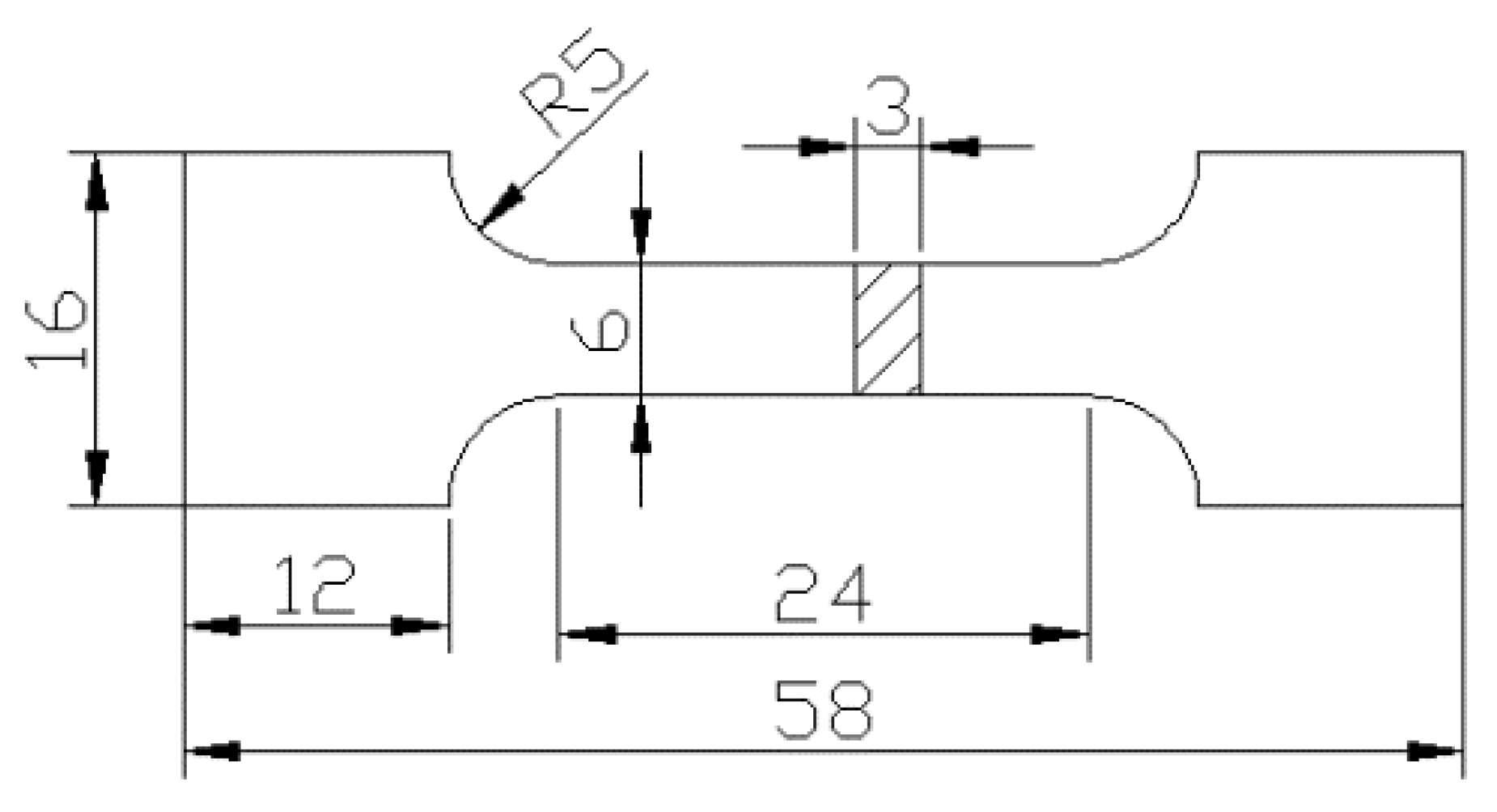

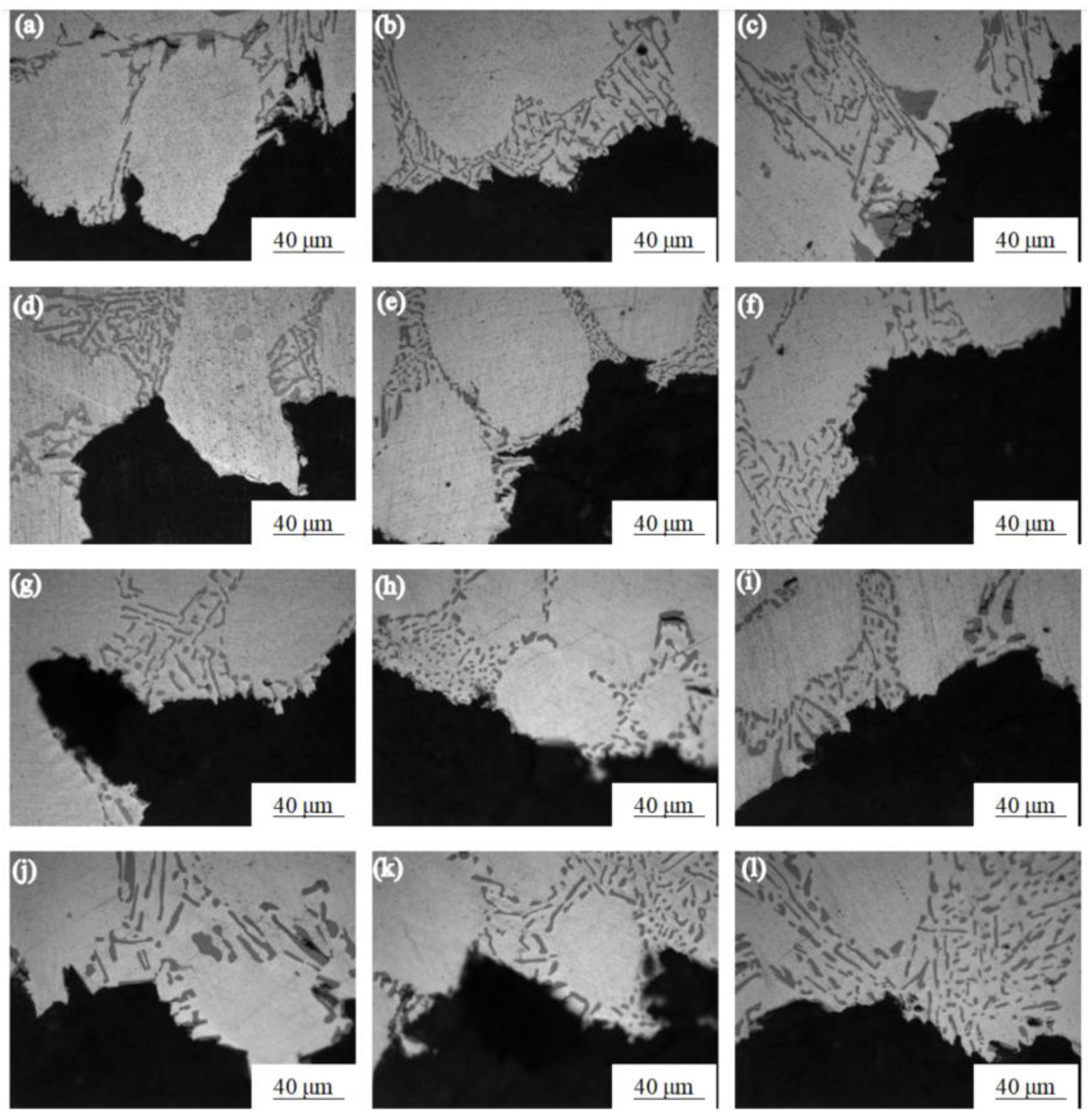


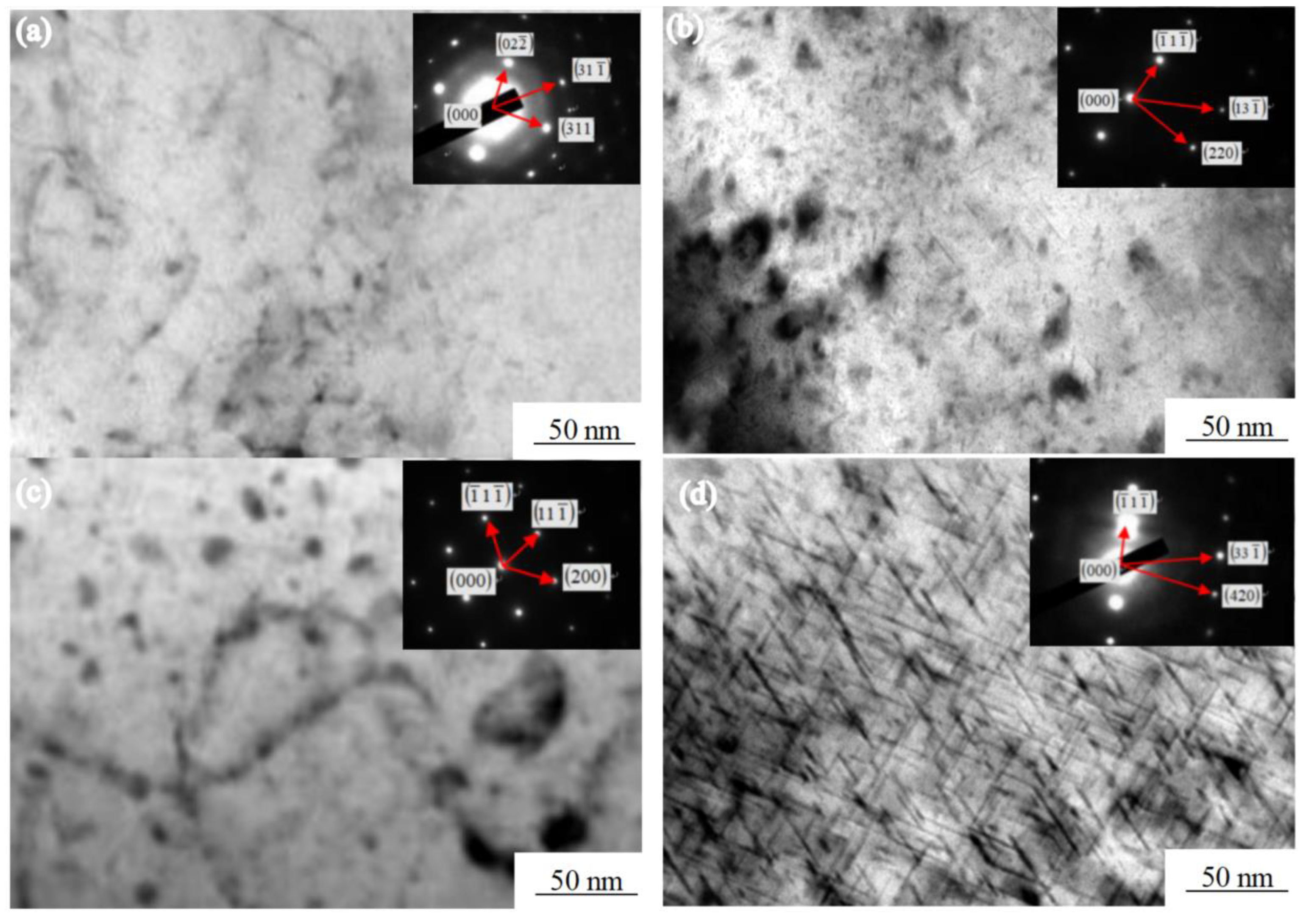

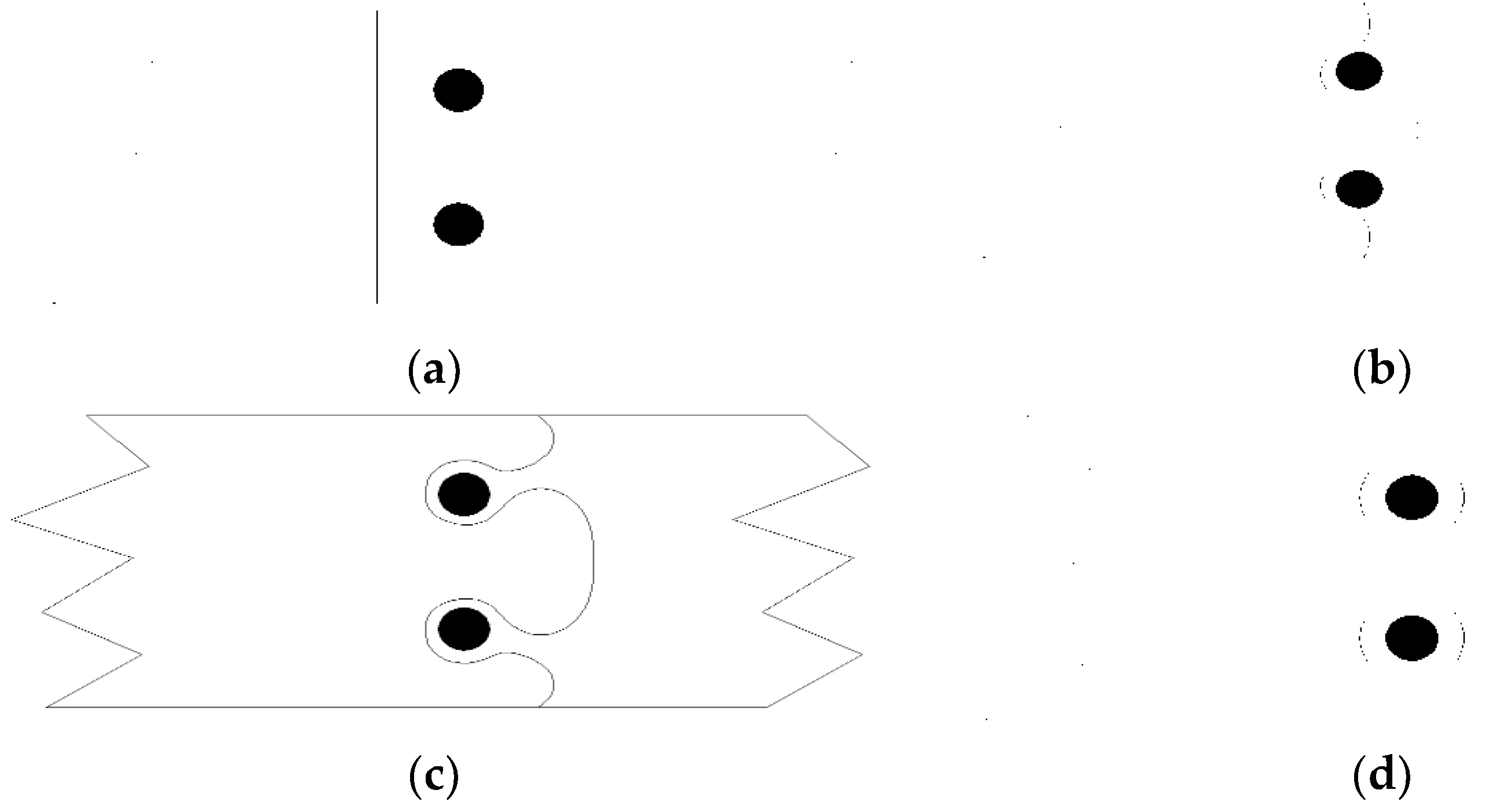
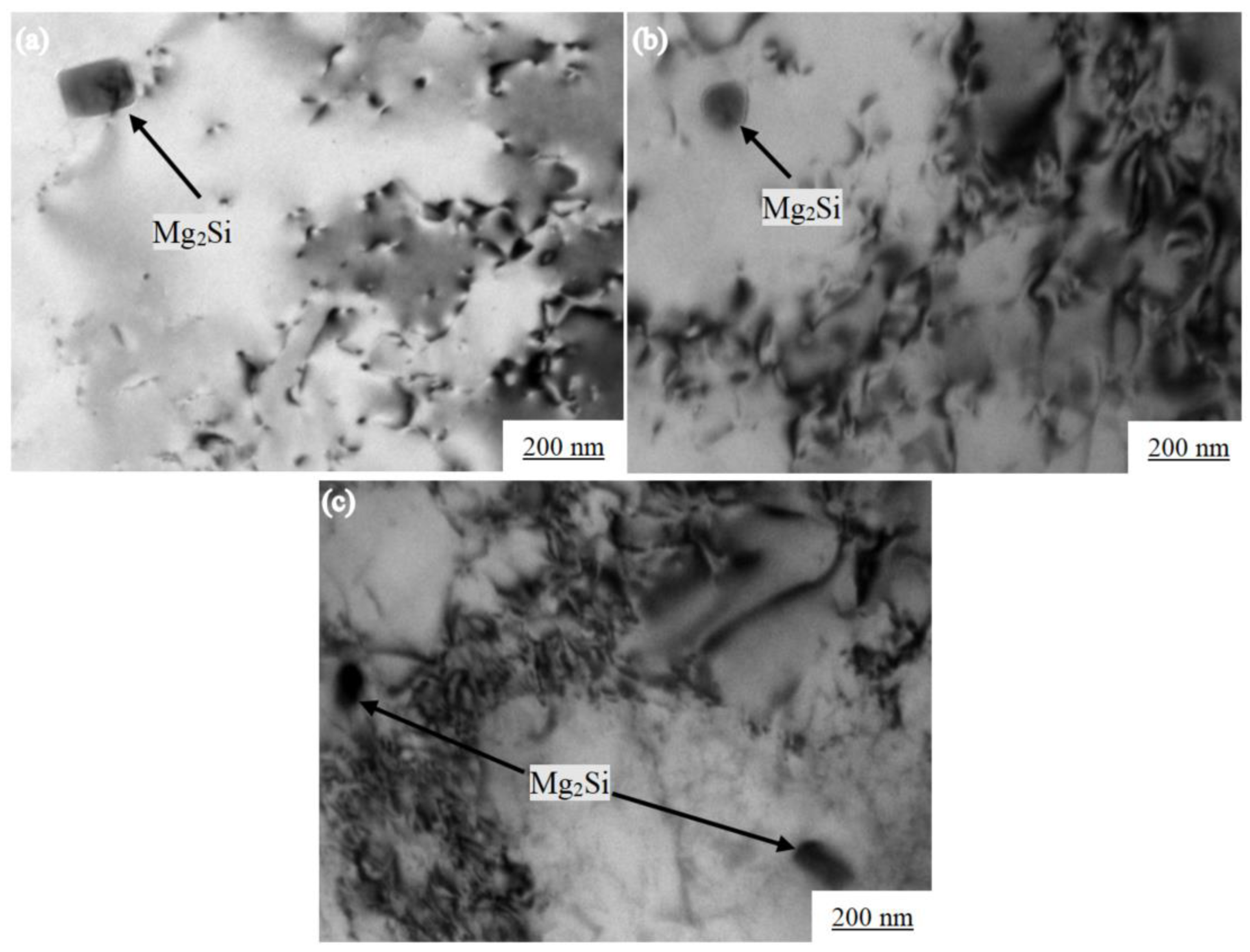
| Si | Mg | Ti | Fe | Cu | Zn | Al |
|---|---|---|---|---|---|---|
| 7.24 | 0.324 | 0.192 | 0.154 | 0.007 | 0.012 | Bal. |
Publisher’s Note: MDPI stays neutral with regard to jurisdictional claims in published maps and institutional affiliations. |
© 2022 by the authors. Licensee MDPI, Basel, Switzerland. This article is an open access article distributed under the terms and conditions of the Creative Commons Attribution (CC BY) license (https://creativecommons.org/licenses/by/4.0/).
Share and Cite
Ma, G.; Yang, M.; Geng, Z.; Ding, Y.; Liu, H.; Jin, Y. Effect of Heat Treatment on Mechanical Properties and Fracture Behavior of Al-7.0Si-0.3Mg Alloy at Low Temperature. Crystals 2022, 12, 563. https://doi.org/10.3390/cryst12040563
Ma G, Yang M, Geng Z, Ding Y, Liu H, Jin Y. Effect of Heat Treatment on Mechanical Properties and Fracture Behavior of Al-7.0Si-0.3Mg Alloy at Low Temperature. Crystals. 2022; 12(4):563. https://doi.org/10.3390/cryst12040563
Chicago/Turabian StyleMa, Guanghui, Mengmeng Yang, Zhe Geng, Yunpeng Ding, Hai Liu, and Yujing Jin. 2022. "Effect of Heat Treatment on Mechanical Properties and Fracture Behavior of Al-7.0Si-0.3Mg Alloy at Low Temperature" Crystals 12, no. 4: 563. https://doi.org/10.3390/cryst12040563
APA StyleMa, G., Yang, M., Geng, Z., Ding, Y., Liu, H., & Jin, Y. (2022). Effect of Heat Treatment on Mechanical Properties and Fracture Behavior of Al-7.0Si-0.3Mg Alloy at Low Temperature. Crystals, 12(4), 563. https://doi.org/10.3390/cryst12040563





